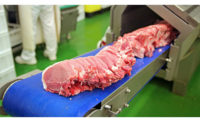Further Automating the Process
By Bryan Salvage, Editorial Director
Consumer demand results in further automation, less product handling.
Evolving technology continues to benefit hot dog processing. And leading equipment manufacturers are quick to point out that the major trends driving their industry -- food safety, increasing throughput, as well as the need for greater equipment flexibility and the desire to reduce labor among other things -- continue fueling the technology evolution.
“We see three trends in hot dog manufacturing all driven by the needs of our customers,” says Russ Martin, president, F.R. Drake Co., Waynesboro, VA. Drake offers a family of machines that align, group, and automatically load hot dogs into virtually any type of package, including vacuum or gas-flushed packages formed on roll-stock packaging machines, boxes, bags, trays, or cans.
“Food safety is the top concern of all hot dog processors,” he adds. “Before making an equipment purchase, they will carefully evaluate the sanitary design of the machinery to ensure it can be easily, quickly, and thoroughly cleaned.”
Cleaning methods have become more aggressive in the past five years, he adds, with processors using stronger cleaning agents, employing rigorous scrubbing methods, and performing frequent microbiological tests. Some processors are routinely scheduling a heat kill step on all equipment in the ready-to-eat (RTE) packing rooms.
Increasing production speeds is the second trend.
“New construction for packaging rooms can cost up to five-hundred dollars per square foot,” Martin says. “As production volumes shift between processors or plants, it is critical to find ways to increase throughput without adding new construction. Hence, faster hot dog loaders and packaging machines are in demand.”
The need for greater flexibility is the third trend. While there are still processors who run the same product for an entire eight-hour shift, this is becoming increasingly rare, Martin points out.
“Processors need versatility for loading and packaging hot dogs,” Martin says. “Some will change over their production line every hour, so they need machines that can be set up in a few minutes.”
Trends within the industry are leading towards full automation, from stuffer through the smokehouse, says Alan G. Miller, president, Risco USA Corp., South Easton, MA.
“Reduction of labor is a key factor [behind this move],” he adds. Risco offers a wide range of equipment including stuffers, mixers, grinders, and linking systems.
Townsend Engineering Co., Des Moines, IA, is the developer of the first machine to automatically stuff, link, and hang sausages, including hot dogs, all in one continuous operation. Early Townsend linkers resulted in more uniform and consistent product using less labor. Townsend remains an industry leader and innovator. Its newest development in sausage processing is its QX® (Quality Coextrusion) system. This fully integrated system simultaneously extrudes a continuous flow of meat batter, along with a thin exterior layer of collagen.
“It fully automates your sausage production process for fresh and cooked/smoked hot dog, cocktail, breakfast, dinner, ring and meat snack products,” says Bob Damstetter, vice president of sales. “Once implemented, the QX system allows the processor to form, encase, link, smoke, and cook sausage all in one smooth and continuous operation.”
In the past, these jobs required up to 50 people. Now, only a few operators are needed to drive the QX system.
Continuous-horizontal processing with co-extruded product is the newest industry trend, says Steve Tennis, president of handtmann Inc., Buffalo Grove, IL. handtmann offers the AL242 for linking and hanging hot dogs in standard cellulose casings and more.
“This eliminates hanging and peeling labor, there is no peeling waste to dispose of, and a more sanitary product is packaged,” Tennis adds. “Our new ConPro System of co-extrusion using alginate for casings is very adaptable to continuous horizontal processing.”
The ConPro (Continuous Process) System associates the benefits of the Ruitenberg food-safe VegaCasing with the modularity of handtmann systems. The basic components of this system are two vacuum fillers: a VF 628 for the product to be filled and a VF 620 for the VegaCasing. Both vacuum fillers provide a regular product flow under continuous pressure. The co-extrusion head smoothly puts a layer of casing around the product, and the thickness of the casing can be adjusted. A product slide filled with fixation solution takes the continuous sausage into the belt system of handtmann’s AL-System filling equipment, strengthening the casing at the same time.
Addressing trends
Drake Loaders address the needs to increase food safety, line speed, and flexibility, Martin says.
“The AMI Sanitary Task Force did a terrific job in developing the Ten Principles of Sanitary Design, as well as a one-thousand point rating system,” he adds. “Drake engineers are trained in these principles and they have incorporated them into the designs of all of our loaders. Some of our customers have performed extensive microbiological testing of Drake Loaders with the intent to identify any trouble spots. They discovered these loaders had no microbiological impact, which was very good news.”
Drake has built its reputation on high-speed applications, Martin continues.
“Fifteen years ago, a ‘high-speed’ hot dog loader ran at 1,000 to 1,200 hot dogs per minute. Drake has dozens of applications running in production at speeds of 1,400 to 1,800 hot dogs a minute, and a few running at speeds up to 2,000 hot dogs a minute,” he says.
Drake Loaders offer versatility in the process, Martin says. “Our Model 2000 is capable of loading 4 1/2-inch long to 12-inch long hot dogs with finished diameters ranging from 16 mm to 32 mm. Most changeovers can be accomplished in five minutes or less. Timing adjustments are stored for every product configuration [recipe], making setup easy and repeatable. Our standard operator interface is a large, color touch screen, and operators can choose either English or Spanish as a language selection.”
Drake’s patented CLX Loading Head facilitates product setups and eliminates the inherent flaws in conventional loading heads that lead to product damage.
Meanwhile, the RS270/8 Risco Frontal Linking System allows the manufacture of links in all casing types so it can be produced in No-jack or natural casings, Risco’s Miller says.
“The advantage of this system is that it is a constant flow system, so delicate casings such as sheep casings have less tendency to ‘blow out,’ Miller adds. “The system is microprocessor controlled and synchronizes with our hanging chain.” This system will be exhibited at this year’s AMI show.
Future opportunities
Equipment suppliers cannot afford to stand still, Martin says. “We are working on some exciting ideas now, and plan to reveal them at the Worldwide Food Expo,” he says.
Hot dog producers will consider alternate casings in the future, with the latest being a coextruded vegetable casing, Miller says.
“If the mouthfeel and strength can be obtained to simulate a sheep casing, the savings are huge, while the production rates are greatly increased as these systems run continuously –the never-ending casing,” he adds. “No time is lost changing casings.”
The Risco RS191 Gel system is producing breakfast sausages as individual links direct into the tray, which reduces labor requirements and rope, Miller says. “Now we are examining the special requirements of the hot dog market to see how this system can be utilized in the continuous production of a quality dog,” he concludes. NP
Technology providers participating in this report include:
F.R. Drake Co., phone (540) 949-6215, e-mail sales@drakeloader.com, or visit www.drakeloader.com
Handtmann Inc., phone (847) 808-1100 or (800) 477-3585, e-mail info@handtmann.com, or visit www.handtmann.com
Risco USA Corp., phone (508) 230-3336 or (888) 474-7267, e-mail info@riscousa.com, or visit www.riscousa.com
Townsend Engineering Co., phone (515) 265-8181 or (800) 247-8609, e-mail info@TownsendEng.com, or visit www.TownsendEng.com
Handtmann Inc., phone (847) 808-1100 or (800) 477-3585, e-mail info@handtmann.com, or visit www.handtmann.com
Risco USA Corp., phone (508) 230-3336 or (888) 474-7267, e-mail info@riscousa.com, or visit www.riscousa.com
Townsend Engineering Co., phone (515) 265-8181 or (800) 247-8609, e-mail info@TownsendEng.com, or visit www.TownsendEng.com



Report Abusive Comment